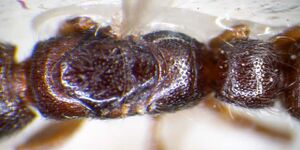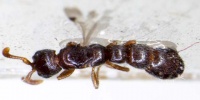Lioponera huode
| Lioponera huode | |
|---|---|

| |
| Scientific classification | |
| Kingdom: | Animalia |
| Phylum: | Arthropoda |
| Class: | Insecta |
| Order: | Hymenoptera |
| Family: | Formicidae |
| Subfamily: | Dorylinae |
| Genus: | Lioponera |
| Species: | L. huode |
| Binomial name | |
| Lioponera huode (Terayama, 2009) | |
Nothing is known about the biology of Lioponera huode.
Identification
Terayama (2009) - This species has elongate head, 11-segmented antennae, concave and carinate anterior margin of petiolar node, and rectangular subpetiolar process.
Distribution
Distribution based on Regional Taxon Lists
Oriental Region: Taiwan (type locality).
Distribution based on AntMaps
Distribution based on AntWeb specimens
Check data from AntWeb
Countries Occupied
| Number of countries occupied by this species based on AntWiki Regional Taxon Lists. In general, fewer countries occupied indicates a narrower range, while more countries indicates a more widespread species. |

|
Estimated Abundance
| Relative abundance based on number of AntMaps records per species (this species within the purple bar). Fewer records (to the left) indicates a less abundant/encountered species while more records (to the right) indicates more abundant/encountered species. |

|
Biology
Castes

| |
| . | |
Nomenclature
The following information is derived from Barry Bolton's Online Catalogue of the Ants of the World.
- huode. Simopone huode Terayama, 2009: 122, figs. 121, 122 (q.) TAIWAN.
- Type-material: holotype queen.
- Type-locality: Taiwan: Taitung Pref., Lan Hsu I., Hungtou, 11.vii.1971 (K. Mizusawa).
- Type-depository: NIAS.
- Combination in Cerapachys: Bolton & Fisher, 2012: 72;
- combination in Lioponera: Borowiec, M.L. 2016: 164.
- Status as species: Bolton & Fisher, 2012: 72; Guénard & Dunn, 2012: 24.
- Distribution: Taiwan.
Unless otherwise noted the text for the remainder of this section is reported from the publication that includes the original description.
Bolton and Fisher (2012) report: Although described as a Simopone species, and reportedly having 11 antennomeres, huode is radically different from any other species examined in this study. We are convinced that this species is not correctly placed in Simopone. From the original description and drawings, and the rather poor photographs of the holotype available at www.niaes.affrc.go.jp, there appear to be 12 antennal segments, the scape is far too long and the eyes are too far forward (although the two eyes are at different levels in the drawing). In addition, the frontal carinae are close together, truncated posteriorly and terminate immediately behind the frontal lobes, as is usually seen in Cerapachys but never in Simopone. The antennal sockets appear almost entirely exposed, the posterior margin of the head and its corners are too rounded, an occipital surface is present, AII (petiole) is not laterally marginate, and the prora appears to have the wrong shape. In the illustrations it is impossible to see the condition of the mesotibial spurs (stated as absent in the description but may have been abraded away or overlooked in the poorly mounted specimen) or whether the pretarsal claws are toothed. Finally, the presence of a metabasitarsal glandular groove is not recorded. Until the holotype can be critically re-examined this species should be regarded as a member of genus Cerapachys (sensu lato).
Description
Queen
Holotype alate female. Head long, 1.17 times as long as wide, with straight posterior margin and convex sides in full face view, posterolateral corner forming a dull angle; frons and vertex moderately punctate. Antenna with 11 segments; scape short, SI - 42; 10th segment as long as wide, terminal segment twice as long as wide. Mandible broad triangular. Eye large and prominent, 0.23 mm in maximum diameter.
Alitrunk with almost straight dorsum. Petiole longer than high, with broadly convex dorsal outline in profile; in dorsal view, dorsal disk slightly wider than long, with concave anterior margin, convex posterior margin, and weakly convex and angulate posteroventral corners. First gastral tergum 0.25 times as long as wide, 0.50 mm in maximum width in dorsal view. Fore wing 2.3 mm in length.
HL 0.71, HW 0.60, SL 0.26, WL 1.00, Pl 0.38, PH 0.36, DPW 0.38, TL 3.4.
Color. Body brown; mandible, antenna, and legs yellowish brown.
Type Material
Holotype. Alate female, Hungtou, Lan Hsu is., Taitung Pref., 11. vii. 1971, K. Mizusawa leg. NIAES.
Etymology
The specific epithet is the Chinese noun Huode, which is the name of a Taiwanese goddess.
References
- Bolton, B. & Fisher, B.L. 2012. Taxonomy of the cerapachyine ant genera Simopone Forel, Vicinopone gen. n. and Tanipone gen. n. (Hymenoptera: Formicidae). Zootaxa 3283, 1–101 (doi:10.11646/zootaxa.3283.1.1).
- Borowiec, M.L. 2016. Generic revision of the ant subfamily Dorylinae (Hymenoptera, Formicidae). ZooKeys 608: 1-280 (doi: 10.3897/zookeys.608.9427).
- Terayama, M. 2009. A synopsis of the family Formicidae of Taiwan. Research Bulletin of Kanto Gakuen University 17: 81-266.
References based on Global Ant Biodiversity Informatics
- Bolton B., and B. L. Fisher. 2012. Taxonomy of the cerapachyine ant genera Simopone Forel, Vicinopone gen. n. and Tanipone gen. n. (Hymenoptera: Formicidae). Zootaxa 3283: 1-101.
- Guénard B., and R. R. Dunn. 2012. A checklist of the ants of China. Zootaxa 3558: 1-77.
- Terayama M. 2009. A synopsis of the family Formicidae of Taiwan (Insecta: Hymenoptera). Research Bulletin of Kanto Gakuen University. Liberal Arts 17:81-266.
- Terayama Mamoru. 2009. A synopsis of the family Formicidae of Taiwan (Insecta, Hymenoptera). The Research Bulletin of Kanto Gakuen University 17: 81-266.
- Terayama, M. 2009. A synopsis of the family Formicidae of Taiwan (Insecta; Hymenoptera). The Research Bulletin of Kanto Gakuen University 17: 81-266.

